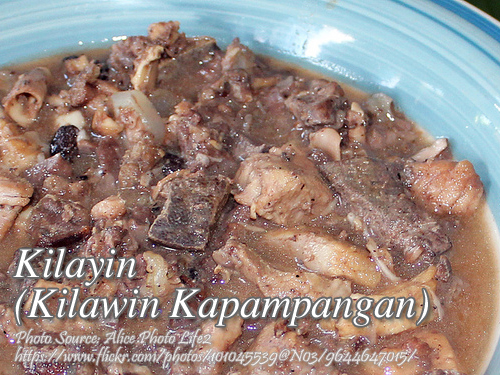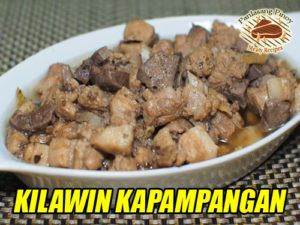Kilawin kapampangan or popularly known as “kilayin” is a kapampangan dish made from minced pork lungs, chopped pork meat and liver, stewed in vinegar with spices and aromatics. When I was still not very familiar with this dish, as I’ve heard from my wife, that this is a tasty dish. She knows it because her mother was kapampangan. I thought it was “kilawin” or ceviche and what I have in mind is the pork lung and innards are only soaked in vinegar and eaten.
So I was disgusted with the dish just thinking of eating it makes me puke. But one day our kapampangan neighbor who became my wife’s friend gave us a bowl of this kilayin. I was wondering why it is cooked since it is “kilawin”. When I tasted it, it was delicious! So my wife was motivated to cook this dish and from that time it was included our regular monthly menu.
Bit of tip from a facebook page member (Catherine Eugenio Laxamana): Marinade the chopped pork lungs with vinegar, onion, garlic with salt and black pepper in another bowl and after a while put it in a pan let it boil, when it dries up add little cooking oil and fry it, so that the pork lungs will be cooked properly and remove the fishy taste. When it’s done, that’s the time to add the pork and the other ingredients.
A Unique Kapampangan Delicacy
Growing up, I had my fair share of encounters with Filipino dishes, but nothing quite prepared me for my first taste of this Kapampangan specialty. My wife, whose family hails from Pampanga, would often talk about how flavorful it was, but I wasn’t sold at first. In my mind, I associated it with kilawin—the fresh, vinegar-soaked ceviche-style dish—which made me hesitant. The idea of eating pork lungs, innards, and liver soaked in vinegar just didn’t sit well with me. But one day, a kind neighbor from Pampanga shared a bowl with us, and my wife finally convinced me to try it. That first bite changed everything—it was nothing like I imagined! Instead of raw and sour, it was richly stewed, savory, and absolutely delicious. From that day on, this dish became a staple on our dinner table.
What Makes This Kapampangan Dish Stand Out?
At its core, this dish is a flavorful stew made from a mix of pork lungs, chopped pork, and liver, all simmered in vinegar with a blend of spices and aromatics. What sets it apart from other Filipino dishes is its unique combination of ingredients that might seem intimidating at first. Pork lungs, liver, and innards aren’t common in everyday cooking for most of us, but don’t let that scare you off. When prepared properly, they bring a depth of flavor and texture that you won’t find in any other dish.
It’s easy to see why this delicacy is so beloved in Pampanga, a province known for its rich culinary traditions. Just like many Filipino dishes, it’s a perfect balance of savory, tangy, and hearty. The key to its flavor lies in the vinegar, which tenderizes the meat and cuts through any richness from the liver and lungs, while the garlic and onions add layers of aroma.
A Common Misconception: Is It Kilawin or Not?
One of the biggest misconceptions about this dish is that it’s the same as kilawin, the Filipino version of ceviche. I was guilty of this confusion myself! It wasn’t until I tried the dish that I realized the difference. Unlike kilawin, which involves raw fish or meat marinated in vinegar, this dish is fully cooked. The vinegar is used not only as a marinade but also as a cooking medium, which helps tenderize the pork and lungs while infusing them with flavor.
So if you’re like me and worried about eating something raw, rest assured—this is a hearty, fully cooked meal that’s bursting with flavor. It’s a wonderful introduction to the unique ingredients that are commonly used in Kapampangan cuisine but might be unfamiliar to others.
Cooking Tips for Tender, Flavorful Pork Lungs
Now, cooking with pork lungs might sound intimidating, but it’s all about the preparation. I remember reading a tip from a Facebook page member, Catherine Eugenio Laxamana, that has been a game-changer for me. She suggested marinating the chopped pork lungs in vinegar, onion, garlic, salt, and black pepper, letting the mixture sit for a while before cooking. Once marinated, the lungs should be boiled to remove any unwanted flavors. After that, a quick fry in a little cooking oil helps give the lungs a delicious, crispy texture while ensuring they’re thoroughly cooked. This step is crucial for removing any strong, fishy taste from the lungs and makes them much more enjoyable to eat.
A Dish with History
Like many Filipino dishes, this Kapampangan recipe carries with it a deep history and cultural significance. Pampanga is often referred to as the culinary capital of the Philippines, and its cuisine reflects a rich blend of indigenous flavors and foreign influences. This particular dish is no exception. With the use of pork lungs, liver, and vinegar, it highlights a time when every part of the animal was used in cooking, minimizing waste while creating deeply flavorful meals.
In the past, using these less common cuts of meat was not only economical but also a testament to the creativity of Kapampangan cooks. They knew how to transform humble ingredients into something extraordinary, a tradition that continues today.
Cooking It Step by Step: My Experience
When I make this dish at home, the process starts with cleaning the pork lungs. It’s important to wash them under running water and give them a good squeeze to remove any impurities. I usually repeat this process twice to make sure the lungs are thoroughly clean. Once that’s done, I chop the lungs finely and set them aside while marinating the pork in vinegar.
In a pan, I sauté garlic and onions until they’re fragrant, adding the chopped pork lungs and marinated pork next. I let everything simmer in the vinegar along with ground pepper and bay leaf, allowing the flavors to meld as the meat cooks. Toward the end, I toss in the liver, seasoning the dish with salt and pepper to taste. As the liquid reduces, the dish becomes a rich, flavorful stew with a slight tang from the vinegar.
Bringing the Flavors Together
What I love most about this dish is how the vinegar tenderizes the meat while balancing out the richness of the liver and lungs. By the time it’s finished cooking, the flavors have all come together in a savory, tangy, and comforting stew that’s unlike anything else I’ve ever tasted. It pairs perfectly with a warm plate of steamed rice, and believe me, once you’ve tasted it, you’ll be coming back for seconds.
A Staple on Our Table
Since that first introduction to this Kapampangan delicacy, it’s become a regular feature in our monthly menu. Even our kids, who were initially hesitant about the idea of pork lungs and liver, have grown to love it. The best part is that it’s a dish that brings a little bit of Pampanga’s rich culinary heritage into our home, making every meal feel special.
If you’ve never tried it before, I encourage you to give it a shot. It might surprise you, just like it did me.
How to Cook Kilayin (Kilawin Kapampangan)
Ingredients
- 1/2 kilo pork kasim shoulder, cut into small strips
- 1/4 kilo pork liver cut into strips
- 1/4 kilo pork lungs chopped fine
- 1 medium onion sliced
- 4 cloves garlic crushed
- 1 tsp freshly ground pepper
- 1 cup vinegar
- 1 bay leaf
- salt and pepper to taste
Instructions
How to cook kilawin:
- Clean the pork lungs by washing in running water. Squeeze the lungs while soaked in water or while washing to squeeze out the impurities.
- Do it twice as much as possible. Drain the lungs then chop into small pieces or finely. Marinate pork in vinegar.
- In a pan saute garlic and onions.
- Add pork lungs and the pork and vinegar, ground pepper and bay leaf.
- Simmer over low fire, when pork is almost tender add liver, pepper and salt to taste.
- Continue cooking till pork is tender and liquid is reduced.
Notes
Cooking Tips:
Choose Fresh Ingredients
For the best flavor, always use the freshest meat and vegetables. Ensure that the meat is properly cleaned and trimmed to remove any impurities. Fresh ingredients enhance the overall taste and texture of the dish.Marinate Thoroughly
Allow the meat to marinate for at least 2 hours or overnight to absorb the flavors fully. Use a combination of vinegar, soy sauce, and spices to achieve a balanced taste. The marinating process also helps tenderize the meat.Balance the Acidity
Adjust the amount of vinegar according to your taste preference to avoid overpowering the dish. Add it gradually and taste as you go to find the right balance. A well-balanced acidity complements the rich flavors of the meat and spices.






Thank you for also including the amount of calories per serving. It is very useful for people who track their caloric intake like me but have a hard time measuring especially with foreign dishes. I know this recipe will be delicious and over eating may be inevitable. More power to you!
Fantastic and authentic menus!
Hi Ramon, thanks for the nice comment! Cheers!